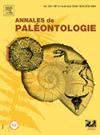Luzon predators: Clues from a fossil with bite marks
IF 0.7
4区 地球科学
Q4 PALEONTOLOGY
引用次数: 0
Abstract
Luzon Island remained isolated throughout its emergent history with its paleofauna often considered depauperate. However, the terrestrial vertebrate fossil record of the island is still poorly known. A new fossil-bearing paleochannel deposit was discovered in La Union Province, northwestern Luzon, Philippines. This paleochannel is inferred to be of Pleistocene age and has yielded fossils tentatively classified as a bovid (Bubalus sp.), a cervid (Rusa sp.), a suid (Sus sp.), and a large crocodile (Crocodylidae). Interestingly, a proximal fragment of the left tibia of a cervid shows multiple bite marks. This study analyzes the bite marks and modifications on the specimen to infer its possible trace maker and explore its implications in understanding the ancient predatory guild of Luzon. Three sets of modifications were recognized on the specimen, namely the bite marks, the broken proximal end and the dry bone fractures. A crocodilian agent for the bite marks is supported by the bisections, their occurrence in the paleofaunal assemblage and the fluvial setting of the deposit. However, an unknown carnivoran agent interpretation cannot be fully disregarded given the ambiguity of bisected marks and the possibly gnawed proximal end of the specimen. Unfortunately, given the lack of in situ context and apparent overprinting, the extent of the peri- and post-mortem modification remains uncertain which hinders the identification of the predatory agent. Verification of the observations reported in this study would require the systematic collection and detailed taphonomic analysis of additional fossil specimens from the deposit.
吕宋岛的掠食者带有咬痕的化石提供的线索
卢松岛在历史上一直与世隔绝,其古生物群通常被认为是贫乏的。然而,人们对该岛的陆生脊椎动物化石仍然知之甚少。在菲律宾吕宋岛西北部的拉乌尼翁省发现了一个新的古河道化石矿床。这条古河道被认为可以追溯到更新世,出土的化石被暂时归类为牛科(sp.)、鹿科(sp.)、麂科(sp.)和大型鳄鱼科(Crocodylidae)。值得注意的是,左侧颈鹿胫骨的近端碎片上有多处咬痕。我们对这些咬痕的分析表明了它们的来源。这对吕宋岛古代食肉动物群的组成具有重要意义。在描述的标本上发现了三个系列的变化:咬痕、近端断裂和干骨上的骨折。观察到的痕迹可能与动物群中鳄鱼的痕迹一致,并且与沉积物的水流环境相吻合。然而,由于咬痕和近端被啃咬的痕迹模糊不清,不能完全排除另一种未知食肉动物的解释。遗憾的是,由于缺乏背景资料和明显的叠印,这些痕迹的改变程度仍不确定,从而阻碍了对食肉动物的最终鉴定。需要对遗址中的其他化石标本进行进一步观察、系统收集和详细的岩石学分析。
本文章由计算机程序翻译,如有差异,请以英文原文为准。
求助全文
约1分钟内获得全文
求助全文
来源期刊

Annales de Paleontologie
地学-古生物学
CiteScore
1.70
自引率
10.00%
发文量
8
审稿时长
>12 weeks
期刊介绍:
Créées par Marcellin Boule en 1905, les Annales de Paléontologie publient 4 numéros par an traitant des fossiles animaux et végétaux, dans tous les domaines de la paléontologie incluant :
-La Paléoanatomie-
La Paléohistologie-
La Morphologie fonctionnelle-
La Systématique-
L''Évolution-
La Paléoécologie
... et toute les contributions susceptibles d''améliorer la compréhension des organismes et des environnements éteints.
 求助内容:
求助内容: 应助结果提醒方式:
应助结果提醒方式:


